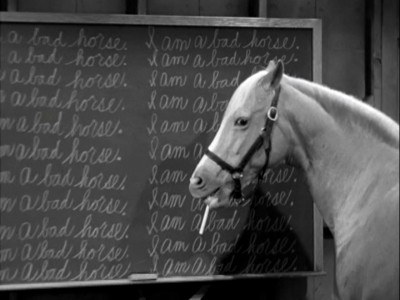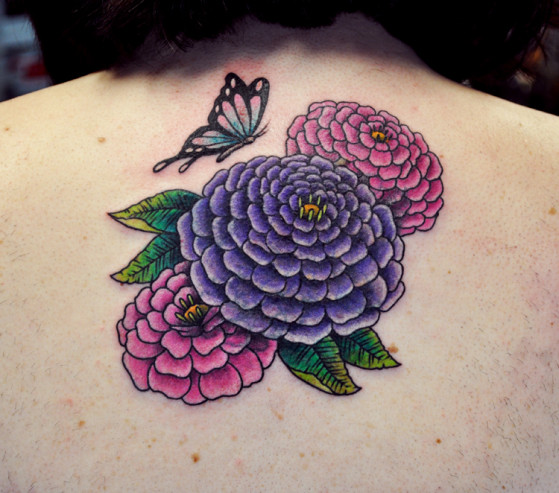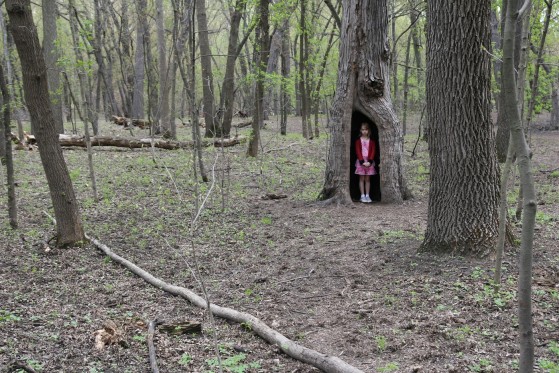To Be Or Not To Be? Finding Ourselves Through Lessons From Mr. Ed.
{source}
In one hour I am going to receive a shipment of dirt.
This is very good news. For some reason none of us who play in the sandbox called my apartment’s Community Garden can quite figure out, the soil there has gone wacko. Here it is, 90 degrees by 10 a.m., and all the beds are refusing to take a drink.
Oh, they pretend to. We’ll turn on the hose and water… and, in time, the soil will look drenched and happily quenched. Water will even pool briefly in spots. But one inch beneath the surface, the dirt remains bone dry. It’s as if the soil’s throat is refusing to swallow… and where it is spitting all that water is anyone’s guess.
You can’t judge a book by its cover — nor, apparently, a garden bed. My fellow Community Gardeners and I are hoping a new infusion of dirt with a better attitude will solve the problem.
But soil is alive. As the Nebraska Statewide Arboretum informed me, “Soil includes microorganisms (bacteria, protozoa and fungi), earthworms, spiders, beetles, springtails, pillbugs, ants and other anthropods.”
You can lead a horse to water, but you can’t make it drink. Here’s hoping that microorganisms and anthropods are less obstreperous than Mr. Ed.
However, regarding those of us on two legs rather than eight, all bets are off. Be real — don’t you know a horse’s ass or two? Sorry, I couldn’t resist.
Actually, I am not talking about jerks but true equus asinus — people who are such donkeys when it comes to living a life of light and growth that they balk when offered anything that even approximates refreshment.
It’s as painful as watching my parched petunias — watching how certain friends or family members stay willfully stuck in deep drought. A hose is right here, waiting to water them with hope, promise, possibility, detente, compromise, a boost of inner B12, you name it… but they refuse so much as one swallow.
Why don’t they want to live?
Or perhaps I should rephrase this. Why are they determined to die? For it is dying that they are doing.
But then I look at myself. And off my high horse I fall flat.
I have met equus asinus, and equus asinus is me.
How many teraseconds of times have I too been led to water but then, inexplicably, turned tail? A terasecond is one trillion seconds, which is about 31,700 years, but you get my point. I mess up a lot.
The wise advice I refuse to hear; the opportunities spurned, the warnings unheeded, the signs missed, the gifts misused, the time wasted, the truths denied — it’s mind-numbing, my obstinance, my myopia. My soil is cement.
Perhaps this is why I love to garden. Gardening is a limitless encore of second chances.
I planted petunias in May and they flourished. Yet by July they were leggy, an ugly starved-green, and bud-less. A savvy Texan clued me in. My petunias had thrived in California because California nights are cool, providing a respite from the heat. In the Texas summer, the only place you need a sweater is indoors, to combat the AC.
Bye, bye, petunias. Hello, zinnias.
The earth laughs in flowers, Emerson claimed. And so can you and I, but only if we are willing to learn. To adapt. To free ourselves from the slave-master called the past.
“Sometimes when you’re in a dark place you think you’ve been buried,” counsels Christine Crain, an activist fighting human trafficking, “but actually you’ve been planted.”
It’s all about switching perspective. Take my little patio plants. This spring and early summer, they lived in deep shade. But one fine morning they awakened to find themselves buried in late-afternoon sun… and they are not taking it well. They remind me of when I was 12, refusing to finish my milk — the drama, the pouting.
They have a point, however. Absolutely they need repotting in a place where, between little sips of sun, they can catch their breath.
I like dappled light, too. My wrinkles show less. Like a pot, I want whatever it takes to brim over with beauty.
Like a pot, I require regular watering.
Like a pot, I can crack and I can break.
And, like my pots, I’ve got some gaps. Indeed one, thanks to my oral surgeon, is a bona fide hole. I have a hole in my mouth in the exact same way my pots have holes where zinnias will go.
Do you know how weird it is to run your tongue over a range of teeth and suddenly plunge into a soft, wet crater? According to motivational healer Louise Hay, this hole, this toothlessness is a consequence — and reflection — of my deep reluctance to make a decision.
Considering that my tooth didn’t decay overnight but over decades — decades of indecisiveness regarding my marriage, career, beliefs, abilities, focus — I am inclined to agree with Louise. Small wonder the surgeon pulled out my tooth in pieces. I’ve been in pieces forever.
But now I am ready to mend. I want that hole filled…
And I want it filled today. Less than one week in, I am heartily sick of chewing on one side. Plus the hole is ugly. I don’t like ugly.
Yet it will take time for my impatiens to regroup and grow strong… It will take time for my zinnias to spread like a thick quilt of yellow and white across my garden bed…
Yes, just as soil must be prepped before flowers and tomatoes can grow in it, so my mouth needs two months to prep properly. The hole must heal and bone must grow, or my new tooth is as doomed as a petunia in August.
Poet May Sarton says it best: “Everything that slows us down and forces patience, everything that sets us back into the slow circles of nature is a help. Gardening is an instrument of grace.”
And what grace awaits me if I am patient with my ugly unplanted state? What is my new tooth called? I love this! A crown!
So I picture myself in a crown (the other kind) and spray these words of Madisyn Taylor at myself. Fingers crossed they’ll sink in and hydrate me forever…
“When we truly grasp that the only way out of any situation in which we find ourselves is to go through it, we stop looking for ways to escape and we start paying close attention to what is happening. We realize that we are exactly where we need to be… we are in this situation in order to learn something we need to know… there is a purpose to our suffering.”
Sometimes this suffering leaves scars. Theologian Richard Rohr reminds us that Christ’s resurrected body included his wounds. His wounds are part of him, just as our wounds are. They are part of our story. The trick is to transcend them.
Rohr also likens this wounding process to the initiations young men in various tribal cultures endured to mark their passage from boyhood to manhood.
“Historically people were marked on their body, too,” Rohr continues, “the remaining wound tells us that we have gone the distance and completed the necessary cycle. ‘I can take it, and I am not a victim, but renewed’ is the message.”
I am not a victim, but renewed! I am not a straggly petunia, but a zinnia with a crown!
Would it be fun or what — to appall the daylights out of my adult children and get a tattoo?
{source}
Read my lips. Read my tattoo. I am tough. I am drought-tolerant. I am zinnia. Watch me re-seed and re-root. Watch me thrive.
On my walks, I while away the steps by memorizing poetry. It is No Accident, I suspect, that it is these lines — from a poem by St. Symeon the New Theologian — that I am tackling this very moment.
And He makes us utterly real.
And everything that is hurt,
Everything that seemed to us
Dark, harsh, shameful,
Maimed, ugly and irreparably damaged,
Is in Him transformed.
Typically it is a fairly effortless process for me, memorizing poetry. But this poem has fought me like a stallion refusing water. I will think I’ve got it down, rejoice that it has become as much a part of me as my children’s names or my future tattoo…
And, then, by the next walk, it’s gone.
I hated Hide-n-Seek as a child, and I really hate it when words hide. But perhaps this is the poem’s way of tagging me. You’re it! Now, go play.
Go find yourself.
{source}




